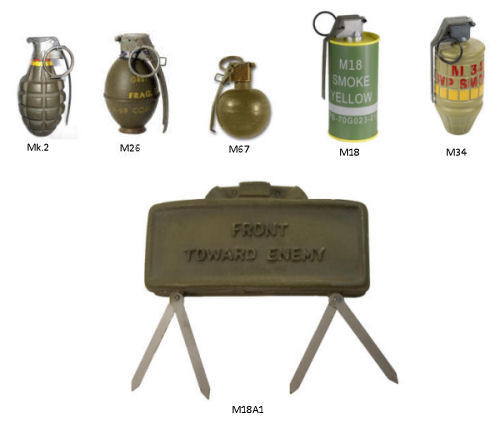introduction
Another remarkable release from
BRAVO-6 to make our Vietnam US figures look more life-like.
New kit
B6-35064 U.S. Grenades & Claymores include 1/35 scale resin cast various types of hand grenades and mines detailed with PE parts and decals.

the kit
It comes in standard cardboard box of the company with two ziplock bags inside. One bag includes 4 resin blocks of 2 types( 3 for first block and 1 for the second) and other bag has PE parts and decals.
First block carries two M67, four M26, four M18/variants and second block three Mk.2, three M34, three Claymores and a detonator. Kit totally includes 36 hand grenades and 3 claymores.
Sculpting is very nice and cast is flawless. Front Toward Enemy on Claymore mine is apparent which makes this kit really deserve to appreciate.
PE parts are 44 safety rings for grenades and 7 parts scissors type folding legs for Claymores to show 2 of them in open and 1 in close position.Parts can be easily removed from PE block.
Printing quality of water slide decals for smoke cans is very nice.The sheet includes decals marked in numbers ;
01. M34 WP Smoke Grenade x3
02. AN-M8 HC White Smoke Grenade x2
03. M6 Riot Control Grenade x2
04. M18 Smoke Grenade Red x2
05. M18 Smoke Grenade Violet x2
06. M18 Smoke Grenade Green x2
07. M18 Smoke Grenade Yellow x2
conclusion
Great set to put realistic look grenades on figures and scenes.It can be used not only for Nam era but more.
Highly Recommended
additional info
Mk.2 is the most popular fragmentation hand grenade used by the U.S. troops during World War II and in later conflicts including the Vietnam War. It was manufactured with grooves in the cast iron which was believed to aid fragmentation and provided for a better grip when throwing the grenade. With a similar appearance, it is known as Iron pineapple. It was filled with EC blank fire (smokeless firearm) powder and commonly referred as a defensive grenade.
M26 was developed right after WW II to replace Mk.2. It entered service around 1952 and was used in combat during the Korean War. Its distinct lemon shape led it to being nicknamed Lemon grenade. It has a thin sheet steel wall that results in a smooth surface, was more reliable and had a more evenly spread fragmentation capacity with the addition of Tetryl to Comp B.
M67 is used as a replacement to M26 series. It is a fragmentation hand grenade to supplement infantry actions on the field, with a spherical steel body that contains Comp. B explosive. It weighs about 400 grams in and can be thrown 30 to 35 meters by the average male soldier. Its fuse delays detonation between 4 and 5 seconds after the spoon is released. Steel fragments are provided by the grenade body and produce an injury radius of 15 meters with a fatality radius of 5 meters , though some fragments can disperse as far out as 250 meters.
M18 - Colored Smoke Grenade is used as a ground-to-ground or ground-to-air signaling device, a target or landing zone marking device, or a screening device for unit maneuvering. It has steel cylinder body with four emission holes at the top and one at the bottom to allow smoke release when the grenade is ignited. Filler contains color smoke mixture in red, green, yellow or violet. Body is in olive drab and smoke color is indicated on the top.
AN-M8 HC - White Smoke Grenade emits a dense cloud of white smoke for 105 to 150 seconds.
M34 - White Phosphorus Smoke Grenade, also known as Willie Pete is a chemical grenade used for signaling, screening or for incendiary missions. The use of this grenade also has a psychological impact on the enemy. Its body is compressed fiber or plastic sphere and filler contains about 425 grams white phosphorus. It has a bursting radius of 35 meters.
M18A1 Claymore is a command-detonated and directional mine, meaning it is fired by remote-control and shoots a pattern of metal balls into the kill zone like a shotgun. It has a curved, rectangular, plastic case and contains a layer of composition C3 explosive. It fires steel balls, out to about 100 metres within a 60 degrees arc in front of the device. It is used primarily in ambushes and as an anti-infiltration device against enemy infantry. It is also used against unarmored vehicles.
Comments